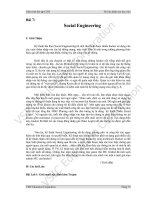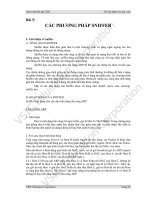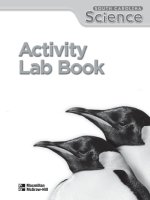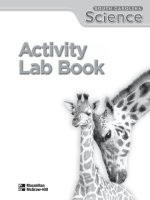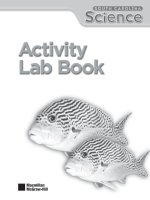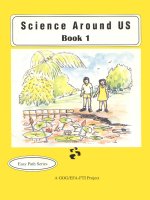science activity lab book fish
Bạn đang xem bản rút gọn của tài liệu. Xem và tải ngay bản đầy đủ của tài liệu tại đây (5.54 MB, 204 trang )
A5ALB_PE_TP_SK07.indd 1 11/7/06 4:11:22 PM
Instructions for Copying
Answers are printed in non-reproducible blue. Copy pages on a light
setting in order to make multiple copies for classroom use.
A5_ALB_FM_SK07.indd 2 11/8/06 10:15:03 AM
© M ac mi ll an /Mc Gr aw –Hill
iii
Activity Lab Book
LIFE SCIENCE
Chapter 1 Cells . . . . . . . . . . . . . . . . . . . . . . . . . . . . . . . . . . . . . . . . . . . . . . . . 5
Chapter 2 Food Chains, Webs, and Pyramids . . . . . . . . . . . . . . . . . . . . . .23
Chapter 3 Ecosystems . . . . . . . . . . . . . . . . . . . . . . . . . . . . . . . . . . . . . . . . .45
EARTH SCIENCE
Chapter 4 Our Dynamic Earth . . . . . . . . . . . . . . . . . . . . . . . . . . . . . . . . . .63
Chapter 5 Land and Water . . . . . . . . . . . . . . . . . . . . . . . . . . . . . . . . . . . .89
PHYSICAL SCIENCE
Chapter 6 Matter and Changes . . . . . . . . . . . . . . . . . . . . . . . . . . . . . . . . . 111
Chapter 7 Using Forces . . . . . . . . . . . . . . . . . . . . . . . . . . . . . . . . . . . . . . 141
Everyday Science Activities. . . . . . . . . . . . . . . . . . . . . . . . . . . . . . . . . . . . 163
Learning Labs . . . . . . . . . . . . . . . . . . . . . . . . . . . . . . . . . . . . . . . . . . . . . . . . 183
Everyday Science Teacher Notes . . . . . . . . . . . . . . . . . . . . . . . . . . . . . . . 199
Learning Lab Teacher Notes . . . . . . . . . . . . . . . . . . . . . . . . . . . . . . . . . . 204
Materials List . . . . . . . . . . . . . . . . . . . . . . . . . . . . . . . . . . . . . . . . . . . . . . . . 208
A5_ALB_FM_SK07.indd 3 11/8/06 10:15:04 AM
A5_ALB_FM_SK07.indd 4 11/8/06 10:15:04 AM
© M ac mi ll an /Mc Gr aw –Hill
v
Activity Lab Book
Science Safety Contract
Dear Parent or Guardian,
Today our science class talked about how to work safely when doing
laboratory experiments. It is important that you be informed regarding the
school’s effort to promote a safe environment for students participating in
laboratory activities. Please review the safety rules and this entire Safety Contract
with your child. This contract must be signed by both you and your child in order
for your child to participate in laboratory activities.
Safety Rules:
1. Listen carefully and follow directions.
2. Perform only those experiments approved by your teacher. If you are not
sure about something, ask your teacher.
3. Take great care when handling and moving chemicals and hot materials.
4. Conduct yourself in a responsible manner at all times.
5. Always clean up after you have fi nished an experiment.
6. Always wash your hands before and after an experiment.
7. Do not eat, drink, or chew gum in the laboratory.
Date: __________
I have read and reviewed the science safety rules with
my child. I consent to my child’s participation in science
laboratory activities in a classroom environment where
these rules are enforced.
Parent/Guardian signature: ___________________________
I know that it is important to work safely in science
class. I understand the rules and will follow them.
Student signature: __________________________________
A5_ALB_FM_SK07.indd 5 11/8/06 10:15:06 AM
© M ac mi ll an /Mc Gr aw –Hill
vi
Guía de actividades de laboratorio
Estimados padres o tutor:
Hoy hemos hablado en nuestra clase de Ciencias sobre cómo mantener
la seguridad al realizar experimentos científi cos. Es importante que ustedes
estén informados del propósito de la escuela de promover un entorno
seguro para los estudiantes que participan en las prácticas de laboratorio.
Por favor, examinen cuidadosamente con su niño o niña las reglas siguientes
y el Acuerdo de Seguridad. El acuerdo debe ser fi rmado tanto por uno de
ustedes como por su niño o niña para que él o ella pueda participar en las
actividades de laboratorio.
Reglas de Seguridad:
1. Escucha con atención y sigue las indicaciones.
2. Haz sólo los experimentos aprobados por tu maestro o maestra.
Pregúntale a él o a ella si no estás seguro de algo.
3. Ejercita sumo cuidado al manipular y transportar productos químicos y
materiales calientes.
4. Compórtate en todo momento de manera responsable.
5. No te olvides de limpiar cuando termines de realizar un experimento.
6. Lávate siempre las manos antes y después de hacer un experimento.
7. No comas, bebas ni mastiques chicle en el laboratorio.
Fecha: __________
He leído y examinado las reglas de seguridad de
ciencias con mi niño o niña. Doy mi consentimiento para su
participación en las actividades del laboratorio de ciencias en
un entorno donde se hagan cumplir estas reglas.
Firma de uno de los padres o tutor: ___________________________
Sé la importancia que tiene trabajar con seguridad en la
clase de Ciencias. Comprendo las reglas y me comprometo a
seguirlas.
Firma del estudiante: __________________________________
A5_ALB_FM_SK07.indd 6 11/8/06 10:15:08 AM
Name
Date
What do you know
about disease?
Purpose
Biologists are curious about the natural world
and everything that lives in it. Susan Perkins and Liliana
Dávolos are biologists at the American Museum of Natural
History in New York City. They investigate organisms by
looking at their cells under a microscope and analyzing
them in the laboratory.
Materials
• paper
• pencil
Susan Perkins Liliana Dávolos
© M acmillan/ McGraw-Hill
Use with Be a Scientist
Activity Lab Book
1
A5_ALB_BAS_SK07.indd 1 11/9/06 9:30:20 AM
Name
Date
How do people get sick?
Do other animals get sick, too?
!
What are some of the same diseases that both people
and other animals get?
© M acmillan/ McGraw-Hill
Use with Be a Scientist
Activity Lab Book
2
A5_ALB_BAS_SK07.indd 2 11/9/06 9:30:21 AM
Name
Date
Explore More
"
How do you think scientists study diseases?
Open Inquiry
Think about a time when you got sick. Write a question
about how you got sick and why. Think about how you
can test your question.
My question is:
How I can test it:
My conclusion is:
© M acmillan/ McGraw-Hill
Use with Be a Scientist
Activity Lab Book
3
A5_ALB_BAS_SK07.indd 3 11/9/06 9:30:22 AM
Name
Date
How do diseases spread?
How do mosquitoes spread disease?
Besides mosquitoes, what are three other ways that
diseases can spread?
!
What are three ways you can help stop the spread of
disease?
"
On a separate piece of paper, design and color a poster
that shows one way to stop the spread of disease.
Materials
• encyclopedia
• Internet
• drawing supplies
© M acmillan/ McGraw-Hill
Use with Be a Scientist
Activity Lab Book
4
A5_ALB_BAS_SK07.indd 4 11/9/06 9:30:23 AM
!
Name
Date
What are plants and
animals made of?
Make a Prediction
Plants and animals are living things. Think about
a plant and an animal you have seen. Do you think
they are made of similar or different parts?
Test Your Prediction
Observe Look at the prepared slide of a plant
leaf under the microscope. For help using the
microscope, ask your teacher.
Record Data Draw what you see.
!
Observe Look at the prepared slide of animal
blood under the microscope.
"
Record Data Draw what you see.
Materials
• microscope
• prepared slides of
plant leaf cells
• prepared
slides of
animal
blood
cells
Step
5
© M acmillan/ McGraw-Hill
Chapter 1 • Cells Use with Lesson 1
Activity Lab Book Types of Cells
A5_ALB_C01_SK07.indd 5 10/30/06 7:08:41 PM
Name
Date
Draw Conclusions
#
Interpret Data How were the plant slide and animal slide
alike? How were they different?
$
Communicate Write a report explaining whether or not
your observations supported your prediction.
Explore More
Examine the drawings you made and think about the living
things they came from. Mushrooms are also living things.
What do you think a mushroom slide looks like? Make a
prediction and plan an experiment to test it.
6
© M acmillan/ McGraw-Hill
Chapter 1 • Cells Use with Lesson 1
Activity Lab Book Types of Cells
A5_ALB_C01_SK07.indd 6 10/30/06 7:08:43 PM
Explore
Name
Date
Open Inquiry
Think about how single-celled and multicelled organisms
are the same and different. Design an experiment that will
compare cells from single-celled organisms and multicelled
organisms.
My question is:
How I can test it:
My results are:
7
© M acmillan/ McGraw-Hill
Chapter 1 • Cells Use with Lesson 1
Activity Lab Book Types of Cells
A5_ALB_C01_SK07.indd 7 10/30/06 7:08:43 PM
Name
Date
Alternative
Explore
How are plant cells and
animal cells similar?
Make a Prediction
Plants and animals are made of cells. Do plant cells
and animal cells have similar structures?
Test Your Prediction
Look for information about plant cells and animal cells in
reference materials. Keep looking until you find written
descriptions and diagrams of the cells.
On a separate piece of paper, draw a Venn diagram of
the parts of animal and plant cells. In the center, write the
parts found in both. List the parts and where they are in
your diagram here.
!
Compare What is different about plant cells and animal
cells?
Draw Conclusions
"
Was your prediction about the structure of plant cells
and animal cells correct? Explain.
Materials
• encyclopedias,
Internet, or
other reference
materials
• ruler
8
© M acmillan/ McGraw-Hill
Chapter 1 • Cells Use with Lesson 1
Activity Lab Book Types of Cells
A5_ALB_C01_SK07.indd 8 10/30/06 7:08:46 PM
Quick Lab
Name
Date
Plant and Animal Cells
Make a Model Put one plastic bag in a storage
container. This is a plant cell. Use another
plastic bag as an animal cell.
Using a spoon, carefully put gelatin in both
bags until the bags are almost full.
!
Choose vegetables that look the most like the
plant-cell and animal-cell organelles.
"
Place the vegetables that you have picked into
the appropriate container and seal the bags.
#
Compare Try to stack your models. How well
do the plant cells stack compared to the animal cells?
$
Communicate Discuss with your classmates which
vegetables you selected for your organelles and
explain why. Write about one of them.
Materials
• sandwich bags
• storage
containers
with lids
• masking tape
(optional)
• pencil (optional)
• gelatin
• vegetables
9
© M acmillan/ McGraw-Hill
Chapter 1 • Cells Use with Lesson 1
Activity Lab Book Types of Cells
A5_ALB_C01_SK07.indd 9 10/30/06 7:08:49 PM
Name
Date
Focus on
Skills
Experiment
All living things are made up of cells. Every cell has a cell
membrane. The cell membrane is a layer around the cell that
lets substances in and out.
Substances move in or out of a cell depending on their
concentrations, or amounts. Substances move from areas
where they are crowded to areas where they are less
crowded. For example, if a cell has a higher concentration
of water than its environment, water will flow out of the cell
until the concentration on the inside and outside is balanced.
One way to learn more about how cell membranes work is by
doing an experiment.
▶ Learn It
An experiment is a test that supports or does not
support a hypothesis. To carry out an experiment you
need to perform a test that examines the effects of one
variable on another using controlled conditions. You can
then use your data to draw a conclusion about whether
or not the hypothesis has been supported.
In the following experiment, you will test the effects of
various substances on a cell membrane. You will gather
and analyze data to support or disprove the following
hypothesis: If the concentration of a substance is higher
outside the membrane, then the substance will move
inside the membrane to balance the concentration.
10
© M acmillan/ McGraw-Hill
Chapter 1 • Cells Use with Lesson 1
Activity Lab Book Types of Cells
A5_ALB_C01_SK07.indd 10 10/30/06 7:08:50 PM
Name
Date
Focus on
Skills
▶ Try It
Measure two eggs using a balance. Record
the measurements in the chart.
Pour 200 mL of vinegar into two jars with
lids. Carefully lower the two eggs into the
jars of vinegar. Tighten the lids and leave the
eggs inside for two days.
!
Use a spoon to carefully remove the eggs.
Rinse the eggs under water.
"
Measure each egg and record the data in
your chart.
#
Pour 200 mL of water into a beaker and
200 mL of corn syrup into another beaker.
Carefully lower an egg into each beaker.
Leave the eggs inside for one day.
$
Use the spoon to carefully remove the
eggs. Rinse the eggs under water.
%
Measure each egg and record the
data in your chart.
First Measurement Second Measurement
Egg in vinegar
2nd egg in vinegar
Egg in water
Egg in corn syrup
Materials
• 2 eggs
• balance
• 2 glass jars with
lids
• 400 mL of vinegar
• 200 mL of water
• 200 mL of corn
syrup
• spoon
• 2 beakers
11
© M acmillan/ McGraw-Hill
Chapter 1 • Cells Use with Lesson 1
Activity Lab Book Types of Cells
A5_ALB_C01_SK07.indd 11 10/30/06 7:08:55 PM
Name
Date
Focus on
Skills
▶ Apply It
&
Now it is time to analyze your data and observations.
Use your chart to compare the masses of the eggs.
Did the mass of both eggs change? Explain why the
masses changed.
Does this experiment support or disprove the
hypothesis?
12
© M acmillan/ McGraw-Hill
Chapter 1 • Cells Use with Lesson 1
Activity Lab Book Types of Cells
A5_ALB_C01_SK07.indd 12 10/30/06 7:08:56 PM
Explore
Name
Date
• growing plant (a
large-leafed plant
will work best)
• aluminum foil
• paper clips
• water
Materials
How does light affect plants?
Form a Hypothesis
Plants need light to grow. What do you think
will happen to a plant’s leaves if you cover parts
of them, so that no light reaches those parts?
Write your answer as a hypothesis in the form
“If parts of a plant’s leaves do not receive any
light, then . . .”
Test Your Hypothesis
Wrap small pieces of aluminum foil over parts of several
leaves. Wash your hands after handling the plant.
Use Variables Cover at least four different leaves of the
plant in the same way.
!
Place the plant in a window where it will get lots of light.
Water the plant with a measured amount of water.
"
Experiment After one day, carefully lift the foil and
check each leaf. Write down your observations. Gently
replace the foil in the same position. Continue your
observations each day for one week. Replace the foil in
the same position each time. How did the areas covered
by the foil differ from the other parts of the leaves?
13
© M acmillan/ McGraw-Hill
Chapter 1 • Cells Use with Lesson 2
Activity Lab Book Photosynthesis: The Basic Process of Life
A5_ALB_C01_SK07.indd 13 10/30/06 7:08:59 PM
Explore
Name
Date
Draw Conclusions
#
Interpret Data How did the changes you observed
progress after one day? After two days? After a week?
How do light and darkness affect the growth of leaves?
$
Infer How do light and darkness affect the growth of
leaves?
Explore More
Remove the foil from the leaves. Water the plant with the
same amount of water you used in the previous week, and
observe it each day for another week. What happens when
the leaves remain uncovered?
14
© M acmillan/ McGraw-Hill
Chapter 1 • Cells Use with Lesson 2
Activity Lab Book Photosynthesis: The Basic Process of Life
A5_ALB_C01_SK07.indd 14 10/30/06 7:09:00 PM
Explore
Name
Date
Open Inquiry
Think of your own question about how plants grow at
different latitudes. Make a plan and design an experiment to
answer your question.
My question is:
How I can test it:
My results are:
15
© M acmillan/ McGraw-Hill
Chapter 1 • Cells Use with Lesson 2
Activity Lab Book Photosynthesis: The Basic Process of Life
A5_ALB_C01_SK07.indd 15 10/30/06 7:09:01 PM
Name
Date
Alternative
Explore
• white carnation
with stem split
lengthwise
• 2 different colors
of food coloring
• 2 glasses or
narrow jars
• water
Materials
How do plants absorb water?
Form a Hypothesis
How does water travel from a plant’s roots to its
stem, leaves, and flowers? Write your answer as
a hypothesis in the form “If water travels through
tubelike structures in a plant’s stem, then . . .”
Test Your Hypothesis
Obtain from your teacher a white carnation that has
its stem cut in half lengthwise.
Fill each glass with water. Add a few drops of food
coloring to one. Add a few drops of food coloring
in another color to the second glass. Place them
next to each other.
!
Place one side of the flower stem in one glass
and the other side of the flower stem in the
second glass. Record your observations.
Draw Conclusions
"
Interpret Data What does this tell you about the way
water is transported in plants?
16
© M acmillan/ McGraw-Hill
Chapter 1 • Cells Use with Lesson 2
Activity Lab Book Photosynthesis: The Basic Process of Life
A5_ALB_C01_SK07.indd 16 10/30/06 7:09:04 PM
Quick Lab
Name
Date
Leaves
Collect a variety of leaves.
Observe Examine each leaf with a hand
lens, and write down each structure that you
can identify.
!
Place a piece of white paper over the leaf, and rub back
and forth with a crayon, making a print of the leaf.
"
Classify On the rubbing, identify the leaf as simple or
compound, and label each structure.
#
Using two different-color crayons, trace the flow of water
and food through the veins.
• variety of leaves
• hand lens
• paper and pencil
• crayons
Materials
17
© M acmillan/ McGraw-Hill
Chapter 1 • Cells Use with Lesson 2
Activity Lab Book Photosynthesis: The Basic Process of Life
A5_ALB_C01_SK07.indd 17 10/30/06 7:09:07 PM
Explore
Name
Date
What can you see through
a microscope?
Make a Prediction
What do you think you will see if you look at an
onion skin, sand, or yeast under a microscope?
Will you see living organisms moving? Write
your prediction in the form “If I look at an onion
skin, sand, or yeast under a microscope, then . . .”
Test Your Prediction
Observe Place a piece of newspaper on a
microscope slide. Place the slide on the stage
of the microscope, and observe it under low power. Draw
what you see. Look at it again under high power. Record your
observations.
Observe Prepare slides with samples of onion skin, sand and
yeast. Repeat step 1 for each sample. Record what you see.
!
Record Data Make a data table to record the details
of what you observed. How many organisms did you
observe? How big were they? What colors were they?
• microscope
• 4 microscope
slides
• dropper
• water
• toothpick
• small pieces of
newspaper
• onion skin
• sand
• yeast
Materials
18
© M acmillan/ McGraw-Hill
Chapter 1 • Cells Use with Lesson 3
Activity Lab Book Microscopic Organisms on Earth
A5_ALB_C01_SK07.indd 18 10/30/06 7:09:09 PM
Explore
Name
Date
Draw Conclusions
"
Observe What did you learn about the way objects
appear when viewed through a microscope? What
happened to your observations as you changed from low
power to high power?
#
Observe Describe the appearance of each of the
samples you observed.
Explore More
Did you see any differences among the samples under the
microscope? Research the types of cells you looked at.
Analyze and present your results.
19
© M acmillan/ McGraw-Hill
Chapter 1 • Cells Use with Lesson 3
Activity Lab Book Microscopic Organisms on Earth
A5_ALB_C01_SK07.indd 19 10/30/06 7:09:10 PM


